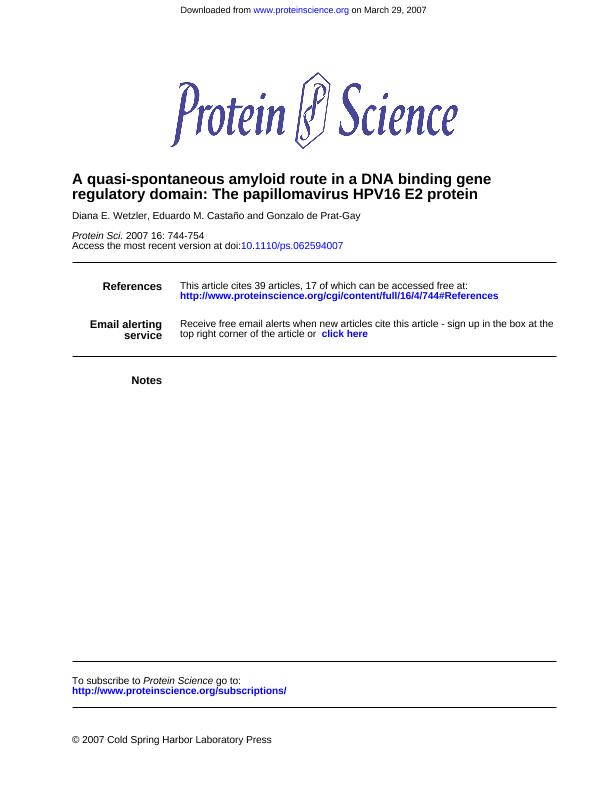Mostrar el registro sencillo del ítem
dc.contributor.author
Wetzler, Diana Elena

dc.contributor.author
Castaño, Eduardo Miguel

dc.contributor.author
de Prat Gay, Gonzalo

dc.date.available
2017-11-14T17:33:09Z
dc.date.issued
2007-12
dc.identifier.citation
Wetzler, Diana Elena; Castaño, Eduardo Miguel; de Prat Gay, Gonzalo; A quasi-spontaneous amyloid route in a DNA binding gene regulatory domain: The papillomavirus HPV16 E2 protein; Wiley; Protein Science; 16; 4; 12-2007; 744-754
dc.identifier.issn
0961-8368
dc.identifier.uri
http://hdl.handle.net/11336/28147
dc.description.abstract
The DNA binding domain of papillomavirus E2 proteins is at the center of the regulation of gene transcription and replication of the virus. Its unique fold consists of a beta-barrel domain that combines an eight-stranded dimeric beta-barrel core interface with two symmetrical DNA binding alpha-helices and other two helices, packed against the central barrel. Treatment with low amounts of trifluoroethanol readily leads to a mostly beta-sheet oligomeric species, with a loss of near-UV circular dichroism signal and increase in its ANS binding capacity, indicating that buried hydrophobic surfaces become accessible to the solvent. This species subsequently undergoes a slow transition into amyloid aggregates as determined by light scattering and Congo red and thioflavin T binding. Electron microscopy shows short amyloid fibers with a curly aspect as the end product. The amyloid route is completely prevented by addition of stoichiometrical amounts of specific DNA, strongly suggesting that unfolding of the DNA binding alpha-helix is required for the formation of the intermediate. The slow nature of this expanded beta-oligomeric species and the availability of several different conformational probes make it an excellent model for investigating amyloid mechanisms. The mild perturbation required for entering an amyloid route is indicative of a preexisting equilibrium. Oligomerization processes are required for the assembly of transcription initiation and DNA replication machineries, where proteins from different viruses must come together with host cell proteins. The E2 protein is a virus-encoded multifunctional master regulator that may exert one of its multiple functions through its ability to oligomerize
dc.format
application/pdf
dc.language.iso
eng
dc.publisher
Wiley

dc.rights
info:eu-repo/semantics/openAccess
dc.rights.uri
https://creativecommons.org/licenses/by-nc-sa/2.5/ar/
dc.subject
Protein Aggregation
dc.subject
Hpv-E2
dc.subject
Oligomers
dc.subject.classification
Otras Ciencias Biológicas

dc.subject.classification
Ciencias Biológicas

dc.subject.classification
CIENCIAS NATURALES Y EXACTAS

dc.title
A quasi-spontaneous amyloid route in a DNA binding gene regulatory domain: The papillomavirus HPV16 E2 protein
dc.type
info:eu-repo/semantics/article
dc.type
info:ar-repo/semantics/artículo
dc.type
info:eu-repo/semantics/publishedVersion
dc.date.updated
2017-11-03T20:23:17Z
dc.identifier.eissn
1469-896X
dc.journal.volume
16
dc.journal.number
4
dc.journal.pagination
744-754
dc.journal.pais
Estados Unidos

dc.journal.ciudad
Hoboken
dc.description.fil
Fil: Wetzler, Diana Elena. Consejo Nacional de Investigaciones Científicas y Técnicas. Oficina de Coordinación Administrativa Parque Centenario. Instituto de Investigaciones Bioquímicas de Buenos Aires. Fundación Instituto Leloir. Instituto de Investigaciones Bioquímicas de Buenos Aires; Argentina
dc.description.fil
Fil: Castaño, Eduardo Miguel. Consejo Nacional de Investigaciones Científicas y Técnicas. Oficina de Coordinación Administrativa Parque Centenario. Instituto de Investigaciones Bioquímicas de Buenos Aires. Fundación Instituto Leloir. Instituto de Investigaciones Bioquímicas de Buenos Aires; Argentina
dc.description.fil
Fil: de Prat Gay, Gonzalo. Consejo Nacional de Investigaciones Científicas y Técnicas. Oficina de Coordinación Administrativa Parque Centenario. Instituto de Investigaciones Bioquímicas de Buenos Aires. Fundación Instituto Leloir. Instituto de Investigaciones Bioquímicas de Buenos Aires; Argentina
dc.journal.title
Protein Science

dc.relation.alternativeid
info:eu-repo/semantics/altIdentifier/url/http://onlinelibrary.wiley.com/doi/10.1110/ps.062594007
dc.relation.alternativeid
info:eu-repo/semantics/altIdentifier/doi/http://dx.doi.org/10.1110/ps.062594007
Archivos asociados
